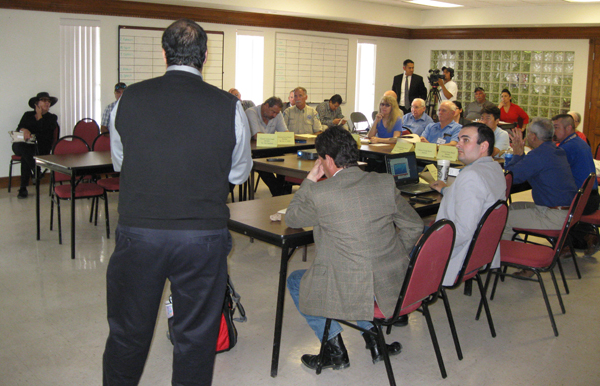- La Feria Community Holds Succesful Business Mixer Event
- Little Nashville to Take Place in Downtown Mercedes
- Lions Basketball Captures District Gold
- La Feria ISD Students Compete in Regional Chess Tournament
- Lions End First Half of 32-4A on a High Note
- La Feria ISD Held Another Successful Parent Conference
- Strong Appearance for Lions at Hidalgo Power Meet
- LFECHS Students Get to Meet Local Actress
- Students Participate in Marine Biology Camp
- Two LFECHS Students Qualify for All-State Band
Public Forum Updates Progress on Water Management
- Updated: March 3, 2015
The scheduled meeting of the Lower Rio Grande Citizens Forum covered a wide range of concerns about water management progress along the Rio Grande and the Arroyo Colorado managed by the United States Section of the International Boundary and Water Commission (USIBWC0). The well-attended meeting was held last week in the USIBWC Conference room at the Mercedes main headquarters.
The meeting got underway with welcome and introductions by Rodolfo Montero, Citizens Forum Co-chair. Montero then presented a slate of expert speakers on the state of water management progress to the attentive audience. This public meeting attracted concerned attendees from such diverse fields as environmentalists, park rangers, law enforcement, farmers, and city managers–all with deep concern about flooding and the availability of water for their needs.

Audience listens to reports by USIBWC officials
Carlos Pena, Jr. P.E. talked about the need for constant attention to water levels and usage along the Rio Grande by farmers, cities and agriculture. Pena is the Principal Engineer of the operations department of the USIBWC based in El Paso.
Pena stressed, “we want to avoid water shortages and prepare for any possibility of a drought as the needs for water users increase with growth.“ He backed his remarks with a brief overview of the Colorado River systems, and proactive efforts by the United States to prepare for adverse conditions. He said the water behind Lake Mead and Lake Power way upstream are distant, but are vital to the health of the river water users on both sides of the Rio Grande. “Each city along the waterways must have their own contingency plans for water conservation in place and use them,” he said, adding, “we have many good plans on the board, but they all depend on federal funding.”
Javier Mendez is the director of Parks and Recreation for the city of Harlingen. Mendez outlined what his city is doing to implement the suggestions made by the government agency. Mendez revealed that Harlingen has a master plan for water management that has been in force since 2009.

USIBWC speakers at Citizens Forum: (l-r) Ramon Navarro, Rodolfo Montero, Javier Mendez.
The plan takes advantage of Harlingen’s Trail System along the Arroyo Colorado as it passes through the city. The plan consists of building and expanding the improved walking trails along the arroyos and connecting them with bridges and boat ramps for kayaks and canoes users. “We believe we can utilize this beautiful resource for recreation to best advantage and prepare for water emergencies at the same time. We are widening and constantly removing trees, brush, weeds and silt along the trails,” he said.
Rodolfo Montero returned to the program with the latest report of Arroyo Colorado Vegetation Maintenance to restore flood control capacity. “That 1967 hurricane Beulah is still the reference point for Valley storms,” he said. “Harlingen was one of the hardest hit towns, but we are taking strong steps to prevent that from happening again. We are working to build and strengthen our dike construction projects to be able to handle more over-flow. The goal is to ‘tame the Arroyo Colorado.’”
Ramon Navarro is a civil engineer with the USIBWC. He outlined the progress in the geotechnical site investigation of upper Brownsville levee cracks. Navarro described how his division is continually taking core penetration tests at the Brownsville Gateway bridge and others along the river to know their condition. He commented that the river has shrunk greatly. “In 1930 the Rio Grande Channel was some 225 feet wide on average. It has decreased to less than 100 feet by 2014–this shrinkage affects many things,” he said, adding, ‘we will have a completed site investigation report later this month, then we will know what we need to do—but, he stipulated, it all depends on federal funding..”
The meeting ended with a lively question and answer session and plans for the next public meeting of the Lower Rio Grande Citizens Forum to be announced later this year.


